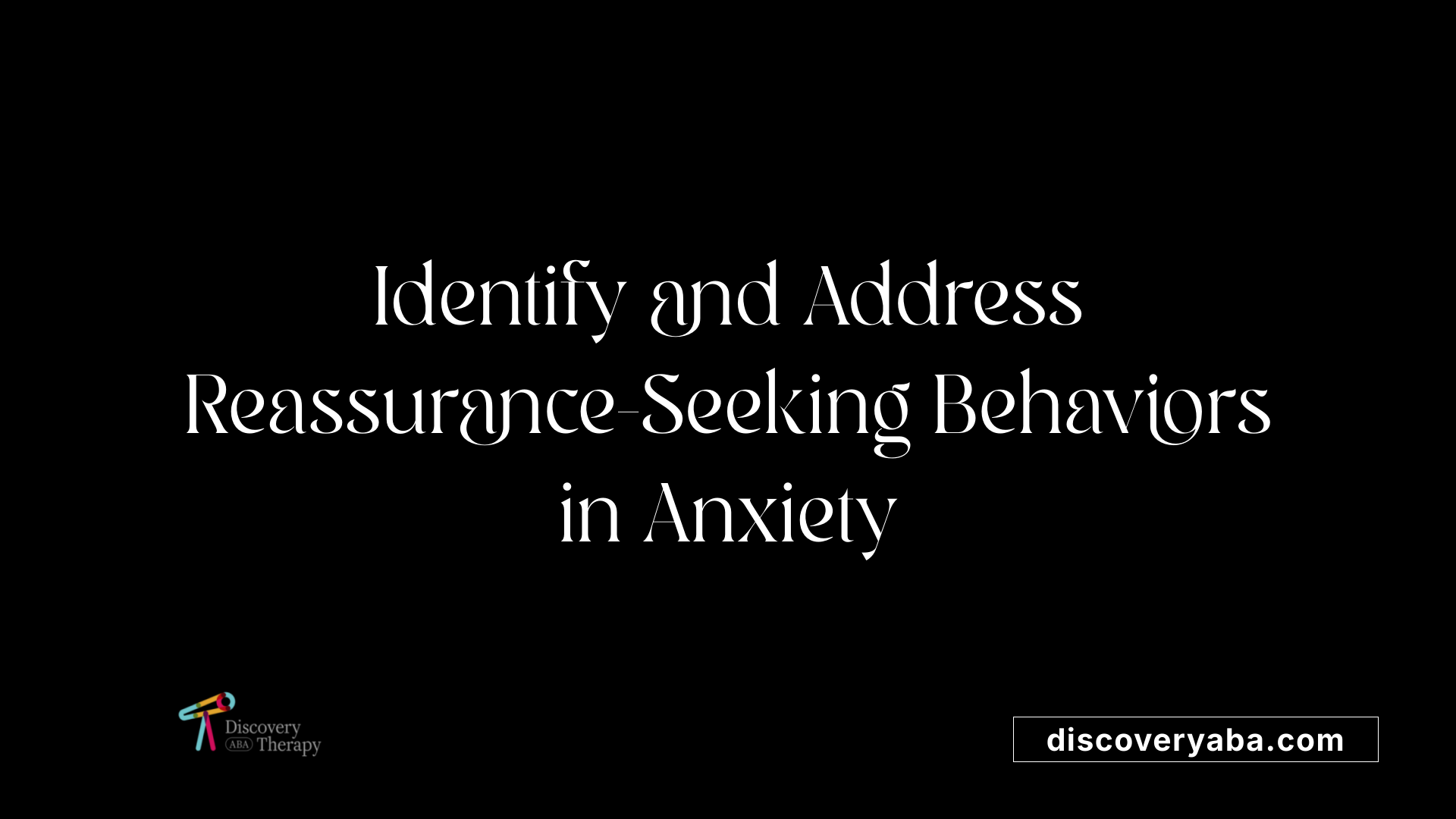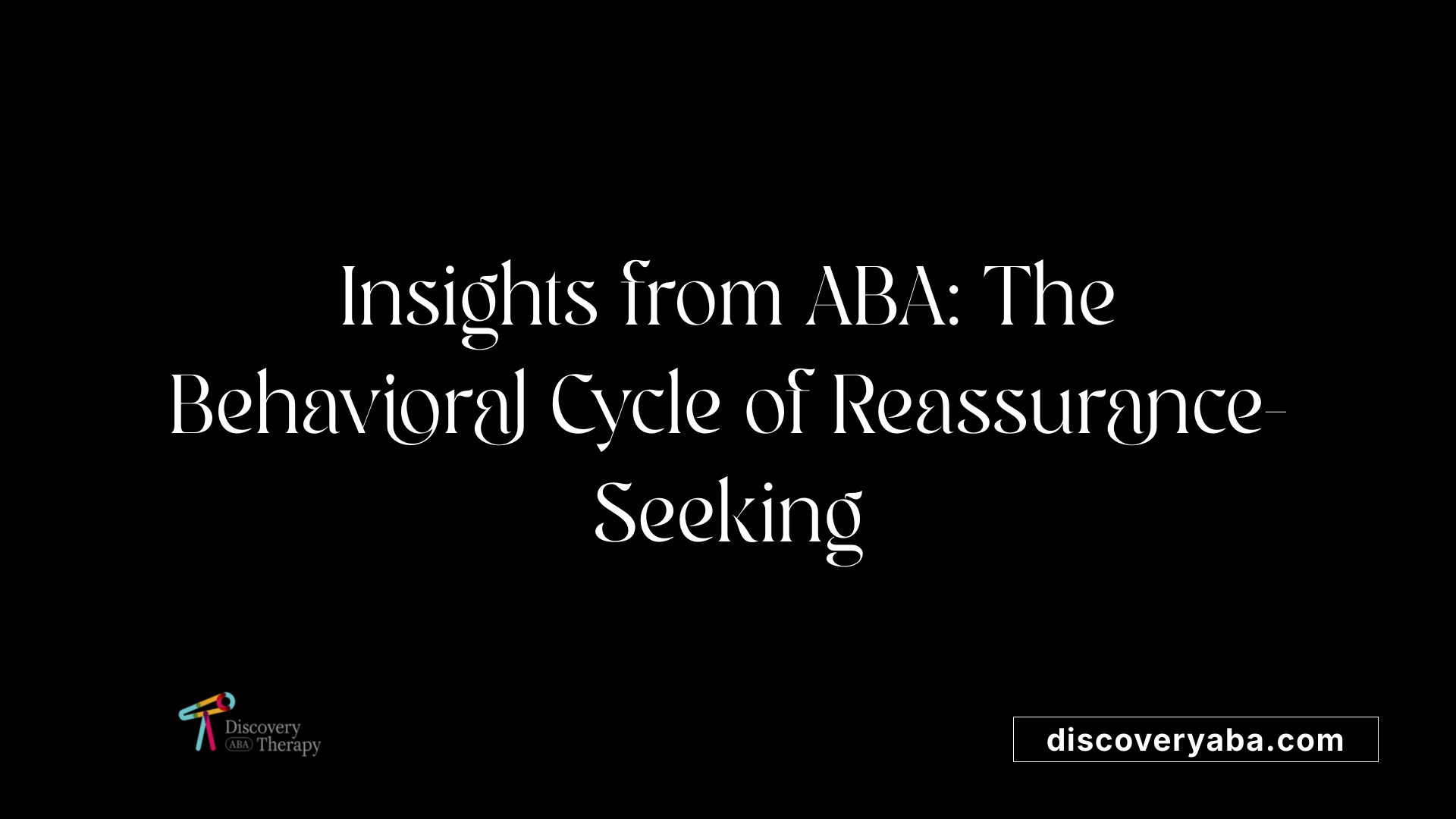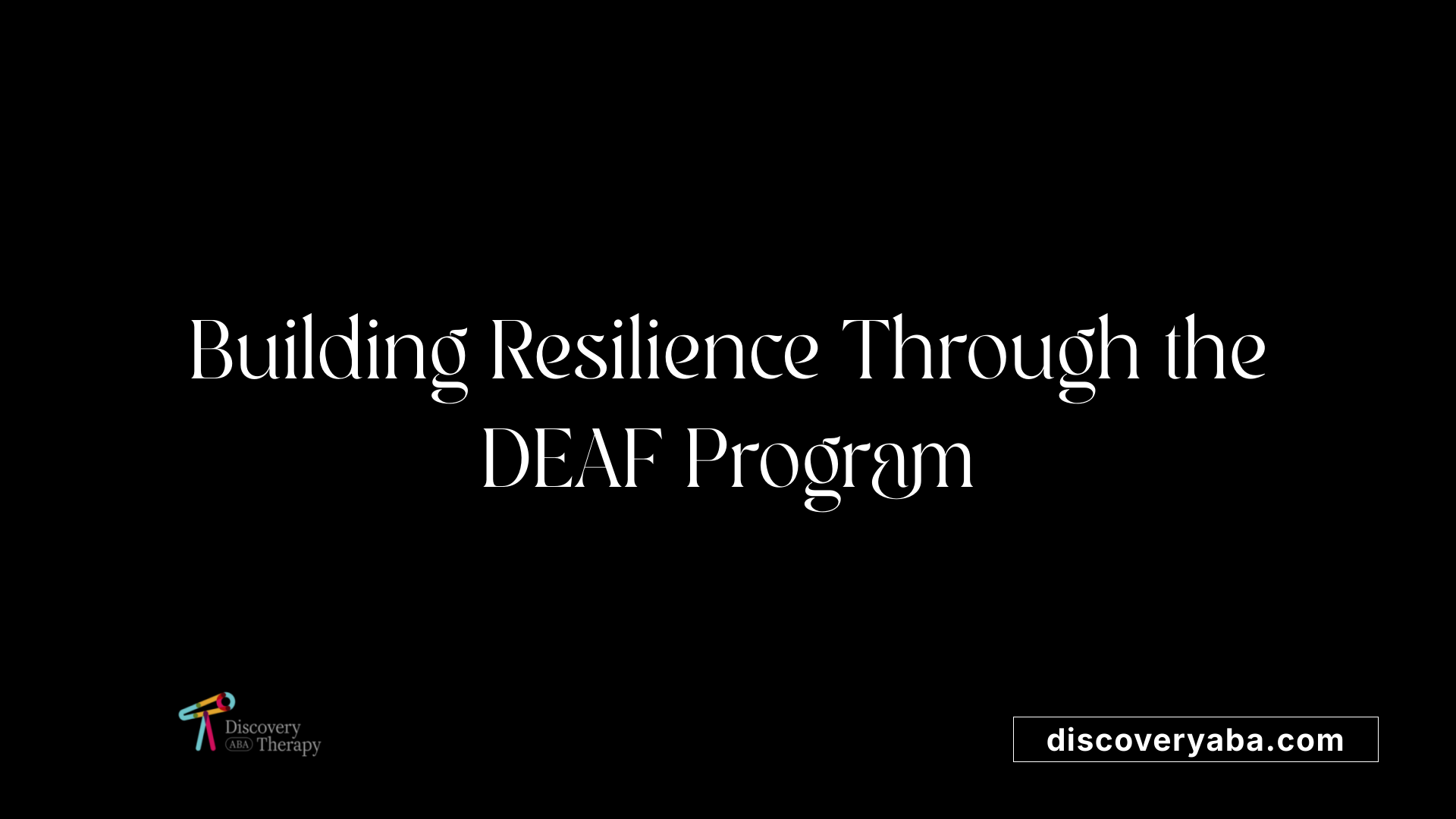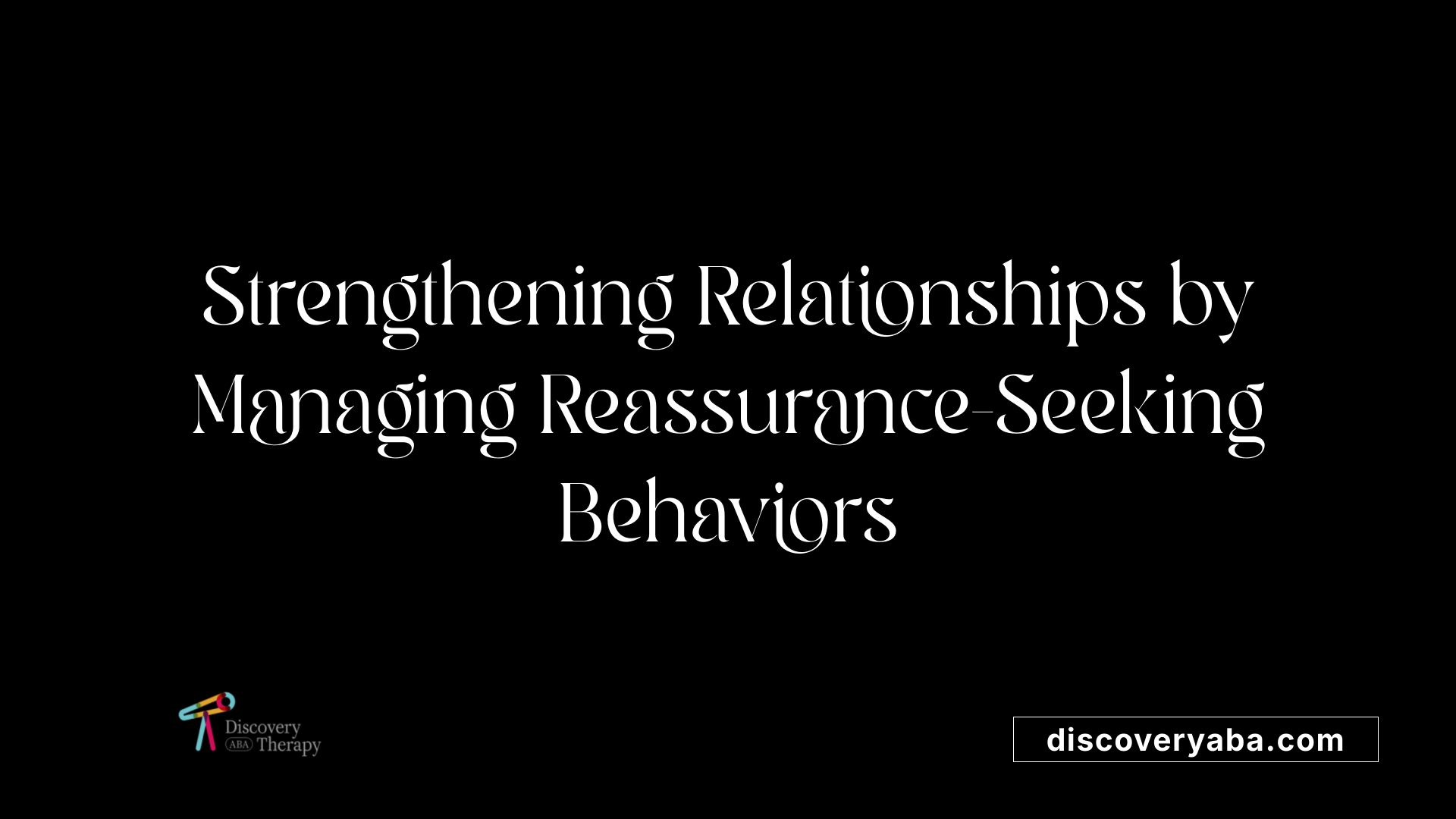ABA strategies for addressing excessive reassurance-seeking
Breaking the Cycle of Reassurance-Seeking: ABA Approaches in Focus

Understanding Excessive Reassurance-Seeking and Its Impact
Excessive reassurance-seeking is a pervasive behavioral pattern often linked with anxiety disorders, OCD, and other psychological conditions. It manifests as persistent attempts to obtain validation or affirmation from others, aiming to reduce feelings of uncertainty, insecurity, or distress. While the behavior provides temporary relief, it usually reinforces anxiety and impairs functioning and relationships. Applied Behavior Analysis (ABA), with its structured and evidence-based approach, offers effective strategies to understand, modify, and reduce this problematic behavior. By systematically analyzing the antecedents and consequences of reassurance-seeking, ABA interventions promote healthier behaviors and resilience.
The Behavior Spectrum and Underlying Causes of Reassurance-Seeking

What are the different types of reassurance-seeking behaviors?
Reassurance-seeking behaviors can take many forms, often driven by underlying anxiety or insecurities. Common behaviors include repeatedly asking others for validation about personal worth, safety, or decisions, such as questioning whether a partner still loves them or if they have done something wrong. This includes checking physical symptoms, excessive internet searches about health concerns, repeated questions to friends or family, and engaging in rituals or rituals that temporarily ease doubts. These behaviors serve as temporary relief but typically reinforce the cycle of anxiety, making reassurance-seeking continuous.
In some cases, reassurance-seeking involves subtle nonverbal cues, like anxious eye contact or constant nodding indicating dependence on external validation. Recognizing these behaviors is important to address them effectively.
Root causes including low self-esteem, childhood trauma, psychiatric conditions
The underlying causes of reassurance-seeking are complex, often rooted in emotional, developmental, and biological factors. Low self-esteem plays a significant role, as individuals with poor self-confidence seek external assurance to feel valued or secure.
Childhood trauma and attachment issues, such as inconsistent caregiving, can impair trust and foster dependency on external validation later in life. Psychiatric conditions such as anxiety disorders (including Generalized Anxiety Disorder and OCD), depression, and health anxiety are also linked to excessive reassurance-seeking behaviors.
In OCD, reassurance acts as a compulsive ritual to reduce intrusive thoughts or fears, especially related to contamination, harm, or moral responsibility. This behavior is reinforced in the short term, maintaining the cycle despite its long-term negative impact.
Other contributing factors include cognitive distortions like catastrophizing, which inflate perceived dangers and prompt reassurance-seeking as a maladaptive coping mechanism.
How does applied behavior analysis (ABA) address reassurance-seeking?
ABA employs structured strategies to modify reassurance-seeking behaviors by changing environmental cues and the consequences that maintain these behaviors.
In practice, ABA techniques involve:
- Recognizing the triggers and antecedents that prompt reassurance-seeking.
- Reinforcing alternative, adaptive behaviors—such as engaging in problem-solving or self-soothing.
- Systematically reducing reinforcement for reassurance behaviors by setting clear boundaries, like not providing reassurance unless certain criteria are met.
- Teaching clients to tolerate uncertainty through gradual exposure, thereby decreasing dependence on external validation.
For example, response blocking—deliberately avoiding providing reassurance—can discourage compulsive behaviors. Simultaneously, teaching mindfulness and emotional regulation skills helps clients accept doubts without acting on them.
What strategies are effective for reducing reassurance-seeking?
To effectively reduce reassurance-seeking, several evidence-based methods are recommended:
- Implementing the DEAF (Distinguish, Embrace, Avoid, Float) program to accept uncertainty and prevent compulsive reassurance.
- Differentiating between normal doubts and compulsive reassurance, focusing on accepting uncertainty as an inherent part of life.
- Practicing mindfulness to observe thoughts without reacting or seeking external validation.
- Using cognitive-behavioral techniques such as exposure and response prevention (ERP), where clients confront doubts without engaging in reassurance behaviors, gradually building tolerance.
- Developing personalized behavioral goals that challenge compulsive checking or reassurance and encouraging self-validation.
These strategies help clients regain control and develop healthier ways to cope with uncertainty.
How can intervention methods vary across different groups?
Intervention techniques are tailored to different populations based on specific needs:
- In OCD clients, ERP aims to expose individuals to triggers without offering reassurance, reducing compulsive rituals.
- For those with health anxiety, gradual testing and behavioral experiments are used to challenge catastrophic beliefs.
- In adolescents and young adults, addressing peer and social influences through emotional regulation and communication training can reduce reassurance dependency.
- Couples or family therapy may focus on improving communication and reducing reassurance behaviors within relationships.
In all cases, incorporating emotional support and fostering self-efficacy are crucial, as they promote resilience and internal coping skills.
What is the role of ABA in managing compulsive reassurance behaviors?
ABA addresses compulsive reassurance behaviors by precisely identifying their functions—typically, reducing anxiety or avoiding perceived threats—and systematically modifying environmental variables that reinforce them.
Therapists may employ:
- Functional behavior assessments to understand specific triggers and motivations.
- Reinforcement strategies that promote alternative behaviors, such as problem-solving or relaxation techniques.
- Response prevention, which involves resisting the urge to seek reassurance, and teaching clients to tolerate uncertainty.
- Reinforcing efforts to return control internally rather than externally.
Over time, ABA techniques help individuals develop healthier patterns by gradually diminishing reliance on reassurance and increasing adaptive coping mechanisms.
Are there educational resources available for understanding reassurance-seeking behaviors through ABA?
Yes, numerous resources exist for professionals and families seeking to learn more about addressing reassurance-seeking behaviors using ABA. These include:
- Professional manuals and guides authored by Behavior Analysts that elaborate on functional assessment and intervention strategies.
- Online courses and webinars covering ABA principles applied to OCD, health anxiety, and related conditions.
- Treatment manuals and manuals for specific protocols like exposure and response prevention.
- Educational websites that translate technical concepts into accessible language for families and caregivers.
Engaging with these resources enhances understanding, supports consistent application of intervention strategies, and fosters effective management of reassurance-seeking behaviors across settings.
The Behavioral Process in Reassurance-Seeking: Insights from ABA

Underlying behavioral mechanisms
Applied Behavior Analysis (ABA) offers a structured way to understand and modify reassurance-seeking behaviors, especially those driven by anxiety or insecurity. At its core, reassurance-seeking is often maintained by a cycle of negative reinforcement: individuals seek validation or confirmation to temporarily reduce their distress. However, this relief is short-lived, leading to repetitive behaviors that escalate over time.
In therapy, ABA focuses on identifying the specific triggers — such as doubts about safety, health, or personal competence — and understanding the functions these behaviors serve. Many reassurance-seeking actions, like asking the same question repeatedly or checking physical symptoms, serve to momentarily lessen uncertainty, albeit at the cost of reinforcing the underlying anxiety.
Intervention points in ABA involve teaching individuals to recognize their triggers and respond differently. This is achieved through reinforcement of more adaptive responses, such as engaging in mindfulness, tolerance of uncertainty, or problem-solving strategies instead of reassurance-seeking. Structured exposure techniques gradually help individuals face their worries without resorting to reassurance, thereby weakening the behavior’s reinforcement cycle.
Behavioral interventions also include the use of a systematic approach—like the DEAF program—to help individuals accept doubt without needing constant external validation. Overall, ABA aims to modify the behavioral patterns that sustain reassurance-seeking, promoting healthier ways to cope with anxiety and uncertainty.
Implementing ABA Techniques: Antecedent and Consequence Strategies
In clinical settings, Applied Behavior Analysis (ABA) offers practical methods to reduce excessive reassurance-seeking behaviors. Central to ABA is the concept of modifying both antecedents and consequences that influence the behavior.
Antecedent strategies involve altering the environment to minimize triggers that prompt reassurance-seeking. For example, clinicians might establish routines that provide predictability and reduce uncertainty, thereby decreasing the individual's need for external validation.
Consequence strategies focus on ensuring that reassurance-seeking does not result in reinforced relief. When a person seeks reassurance, instead of providing immediate validation, clinicians may redirect their attention to adaptive coping techniques or encourage self-affirmation. This helps in weakening the reinforcement cycle that sustains reassurance behaviors.
A systematic approach includes teaching alternative skills, such as mindfulness or problem-solving, to increase self-efficacy. Reinforcing these behaviors instead of reassurance fosters a more resilient and independent response to anxiety.
Setting clear boundaries around reassurance acts as a crucial step. For instance, limiting reassurance to what is truly necessary prevents accidental reinforcement, which can perpetuate the cycle.
Through consistent application of these principles, ABA helps reconfigure environmental contingencies, encouraging individuals to develop healthier ways to manage their worries while diminishing reliance on reassurance-seeking behaviors.
Learning to Tolerate Uncertainty: The Role of the DEAF Program

How can the DEAF program help in building tolerance for uncertainty?
The DEAF (Distinguish, Embrace, Avoid, Float) program is a mindful approach designed to help individuals navigate their feelings of doubt and reduce compulsive reassurance behaviors. The first step, 'Distinguish,' encourages recognizing the difference between normal doubts and those driven by anxiety or compulsive urges. This recognition helps prevent overreacting to uncertainty. 'Embrace' involves accepting uncertainty as a natural part of life, acknowledging that some questions may remain unresolved.
The third step, 'Avoid,' guides individuals to steer clear of reassurance rituals—such as incessant questioning or checking—that reinforce anxiety rather than relieve it. Finally, 'Float' emphasizes practicing mindfulness, observing thoughts and feelings without reacting impulsively. This facilitates emotional regulation and helps break the cycle of reassurance seeking.
By systematically applying these steps, the program fosters resilience against anxiety and empowers individuals to tolerate uncertainty more effectively.
How does avoiding reassurance rituals improve emotional health?
Reassurance rituals, such as repeatedly asking others for validation or engaging in compulsive checking, tend to provide short-term relief but ultimately maintain and strengthen anxiety. Avoiding these compulsive behaviors allows individuals to confront their doubts directly, reducing their dependence on external validation.
Consistent practice in resisting reassurance rituals can lead to increased confidence in one's judgment and diminish the fear associated with uncertainty. Over time, this process helps create new, healthier ways to cope with worries, decreasing the likelihood of getting trapped in reassurance cycles.
What techniques are recommended for reducing reassurance-seeking behavior?
Among the most effective strategies are those rooted in evidence-based treatments like Cognitive-Behavioral Therapy (CBT) and Exposure and Response Prevention (ERP). These techniques include:
- Building awareness of reassurance-seeking triggers and patterns.
- Practicing the DEAF program to develop acceptance and mindfulness skills.
- Gradually delaying reassurance to increase tolerance for uncertainty.
- Challenging negative thoughts related to fears and doubts.
- Developing alternative coping strategies such as journaling, distraction, or engaging in valued activities.
Supporting individuals to resist reassurance behaviors involves a systematic process where the focus shifts from seeking external validation to trusting one's internal resources. Over time, these strategies help diminish compulsive reassurance and reduce overall anxiety.
Relationship Dynamics and Emotional Support in Managing Reassurance-Seeking
 Addressing reassurance-seeking behaviors involves understanding their impact on personal relationships. Excessive reassurance-seeking can create strain between partners, friends, or caregivers by leading to frustration or emotional exhaustion. Over time, this can cause misunderstandings, resentment, or withdrawal, which weaken the emotional connection. Recognizing these patterns is crucial for developing effective coping strategies.
Addressing reassurance-seeking behaviors involves understanding their impact on personal relationships. Excessive reassurance-seeking can create strain between partners, friends, or caregivers by leading to frustration or emotional exhaustion. Over time, this can cause misunderstandings, resentment, or withdrawal, which weaken the emotional connection. Recognizing these patterns is crucial for developing effective coping strategies.
Several intervention methods have proven effective across diverse populations. Cognitive-behavioral techniques, particularly exposure and response prevention (ERP), are widely used to help individuals tolerate uncertainty and reduce compulsive reassurance behaviors. In OCD, these strategies focus on gradually resisting the urge to seek reassurance, building trust in uncertain situations, and redirecting behaviors toward problem-solving.
For individuals with health anxiety, behavioral goals include reducing checking and reassurance acts by implementing gradual exposure to uncertainty, which diminishes the compulsive need for reassurance. Strategies also involve continuous testing of new coping methods, like mindfulness practices, to break the cycle of anxiety reinforcement.
Shifting from reassurance to emotional support is another effective approach. Rather than constantly seeking validation, individuals are encouraged to seek emotional support — which involves sharing feelings, fostering understanding, and building resilience. This process promotes a sense of calm and connection, reducing dependence on external validation.
Combining these methods—CBT, exposure, response prevention, and emotional support—tailors intervention to individual needs and enhances overall effectiveness. This integrated approach helps manage reassurance-seeking behaviors, minimizes relationship stress, and improves mental health outcomes, offering a balanced path toward healthier coping mechanisms.
Moving Forward with ABA to Reduce Reassurance-Seeking
Addressing excessive reassurance-seeking through ABA involves a comprehensive understanding of its behavioral functions and implementing tailored interventions. Systematic modification of antecedents and consequences, reinforcement of adaptive behaviors, and fostering acceptance of uncertainty are central to successful outcomes. Prevention strategies like the DEAF program empower individuals to tolerate doubt and avoid compulsive rituals. As research and clinical practice continue to evolve, family and client education remain invaluable. By integrating these strategies, therapists and individuals can break the cycle of reassurance-seeking, ultimately enhancing emotional well-being, relationship quality, and overall functioning.
References
- Addressing Attention-Seeking Behavior With ABA
- Excessive Reassurance Seeking: Form of Challenging Behaviour
- [PDF] Module 6: Reducing Checking and Reassurance Seeking
- When Reassurance Seeking Becomes Compulsive - ADAA.org
- Stop Compulsive Reassurance Seeking in Teens - Ascend Healthcare
- Reassurance Seeking in CBT: A Guide - Number Analytics
- Excessive Reassurance Seeking in Relationships
- Reassurance Seeking in OCD and How to Manage It
- Determinants of Excessive Reassurance-Seeking: Adolescents ...
- Excessive reassurance-seeking | Advances in Psychiatric Treatment
Does Your Child Have An Autism Diagnosis?
Learn More About How ABA Therapy Can Help
Find More Articles
Contact us
North Carolina, Nevada, Utah, Virginia
New Hampshire, Maine
Arizona, Colorado, Georgia, New Mexico, Oklahoma, Texas
.avif)




































































































